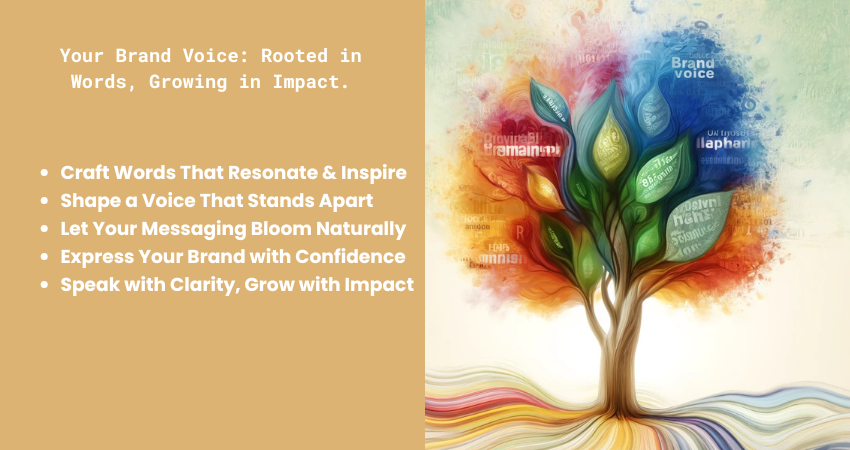Most guides on brand voice sound like a broken record: be consistent, define your tone, and use your audience’s language. While these tips provide a foundation, they fail to address what truly makes a brand voice memorable—its ability to create an emotional connection, break industry norms, and feel unmistakably distinct. While these are good starting points, they don’t necessarily help you craft a brand voice that stands out.
Table of Contents
Toggle
Who Is This Guide For?
This guide is for business owners, marketers, content creators, and entrepreneurs who want to develop a brand voice that truly stands out. Whether you’re launching a new brand, rebranding, or refining your messaging, this approach will help you move beyond generic advice and craft a voice that feels uniquely yours.
Let’s take a different approach. This guide focuses on fresh, strategic ways to shape a brand voice that feels distinctly yours—one that people recognize even without seeing your logo.
For a deeper understanding of how to maintain a consistent brand voice across digital channels, check out this guide.
Find the Contradictions in Your Industry
Every industry has a dominant voice style. Tech brands are usually sleek and minimal. Finance brands sound authoritative and serious. Wellness brands lean on warmth and positivity.
But what happens when a tech brand adds a sense of humor? Or a finance brand speaks with empathy rather than numbers?
Finding contradictions—and owning one—can create a brand voice that instantly grabs attention.
🔥 Exercise:
- List five common tones in your industry.
- Now, flip the script—what’s the opposite of each?
- Can you blend two contrasting tones in a way that makes sense for your brand?
Example:
- Most cybersecurity brands use fear-based language.
- A fresh approach? A brand that reassures, educates, and empowers with confidence—no scare tactics.
Finding this unexpected angle will help shape a brand voice that breaks the mold.
If you’re a startup, developing an authentic brand voice is key to differentiation. Learn how to do that effectively in this article.
Turn Your Personal Quirks into Brand Language
People relate to real, imperfect, and human-sounding brands. Instead of forcing a brand voice, look at how you naturally communicate and lean into it.
🔥 Exercise:
- Scroll through your emails, texts, or notes—how do you naturally explain things to people?
- What words, phrases, or expressions do you always use?
- Do you have an unusual way of simplifying complex ideas?
Example:
- An investment firm that skips jargon and explains finances like you’re talking to your best friend over coffee.
- A skincare brand that describes products like a beauty-obsessed older sister giving advice.
Authenticity is the easiest way to make your brand voice stick. People remember brands that sound like real people.
Use Sensory Triggers to Make Your Voice Memorable
Words aren’t just words—they trigger emotions, images, and memories. If your brand’s voice is forgettable, it’s probably too neutral.
🔥 Exercise:
Think of your brand as a sensory experience:
- If your brand was a sound, what would it be? (A whisper, a drumbeat, a jazz tune?)
- If it had a texture, how would it feel? (Smooth like silk, rough like bark, soft like marshmallows?)
- If it had a taste, what would it be? (Bold espresso? Fresh citrus? Warm cinnamon?)
Now, infuse these into your language.
Example:
- A coffee brand could describe its flavors like “liquid velvet with a caramel sunrise.”
- A fitness brand might use powerful, punchy words like “ignite, crush, fuel.”
The goal? A voice that’s so vivid, people can feel it.
Need help building a brand voice for your startup? Here’s a comprehensive guide to creating a strong brand voice from scratch.
Build a Lexicon—Your Brand’s Signature Words
Every brand needs a word bank—a collection of words and phrases that only your brand uses consistently.
🔥 Exercise:
- Write down 10-15 words that capture your brand’s energy.
- Find 3-5 words you will never use (because they clash with your voice).
- Create 2-3 signature phrases that reflect your unique personality.
Example:
- A fun, irreverent food brand might use “Ridiculously Good,” “Zero Regrets,” or “Treat Yo’ Self.”
- A luxury travel brand might favor “Exquisitely Crafted,” “Effortless Elegance,” and “Beyond Extraordinary.”
Over time, these phrases become recognizable—even without your logo.
Understanding brand voice and tone is essential when setting rules for your communication style. Read more about it in this article.
Create ‘Rule-Breaking’ Guidelines
Most brand voice guides focus on what you should do. Flip it. Define your brand’s rules to break—this helps your voice stay unique.
🔥 Exercise:
- Write down common writing rules in your industry.
- Now, decide which ones to break intentionally.
- Ask yourself: If your brand were a person at a dinner party, what would make it the most memorable guest? (Would it be the storyteller? The witty conversationalist? The calm, insightful observer?)
Example:
- Traditional brands say, “Avoid contractions.”
- A modern, friendly brand could say, “We love contractions—because we talk like real people!”
- Most brands keep headlines short. A quirky brand might embrace long, playful, storytelling-style headlines.
This rebellious approach shapes a voice that refuses to blend in.
Develop a “Voice Mood Board”
Just like visual branding uses color palettes, your brand voice needs a mood board of words, emotions, and styles.
🔥 Exercise:
- Collect examples of writing that match your brand’s tone. This could be tweets, website copy, or even song lyrics.
- Identify words, sentence structures, and stylistic choices that fit your voice.
- Compare different moods—does your brand voice stay consistent whether it’s writing a product page or a social media caption?
A mood board for words helps keep your brand voice consistent yet adaptable.
Want to know the differences between brand voice and brand tone? It’s crucial to get this distinction right when refining your messaging. Explore more in this breakdown.
Evolve, but Stay Recognizable
Brand voices aren’t set in stone. They evolve as industries, audiences, and cultural trends shift. The key is to adapt without losing your core identity.
🔥 Exercise:
- Revisit your brand’s communication every six months.
- Ask: Is our voice still relevant? Is it getting stronger or weaker?
- Fine-tune it based on how your audience reacts to different styles.
A good brand voice is flexible but never unrecognizable.
A Brand Voice Isn’t Created—It’s Discovered
Forget “crafting” a voice from scratch. Instead, uncover the authentic way your brand naturally speaks and let it evolve. A brand voice isn’t about following rules—it’s about breaking the right ones.
Would your audience recognize your voice even without your logo? If not, it’s time to make it bolder.
A strong brand voice is more than words—it’s an experience.
Ready to Build a Brand Voice That Stands Out?
If you’re a business owner looking to refine your brand’s voice and create a deeper connection with your audience, start today. Need expert guidance? Let’s work together to create a voice that truly represents your brand and drives impact. Make it distinctive. Make it memorable. Make it yours.

One Response